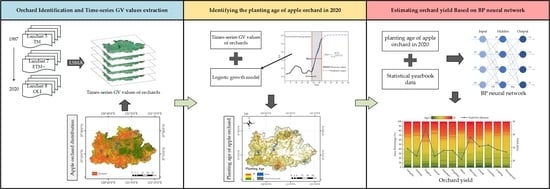Planting Age Identification and Yield Prediction of Apple Orchard Using Time-Series Spectral Endmember and Logistic Growth Model
Abstract
1. Introduction
2. Materials and Methods
2.1. Study Area
2.2. Data Sources
2.2.1. Satellite Data
2.2.2. Field Data
2.2.3. Statistical Yearbook Data
2.2.4. Orchard Planting Suitability Data
2.3. Overall Research Framework
2.4. Estimation of Apple Orchard Planting Age
2.4.1. Linear Spectral Mixture Analysis
2.4.2. Orchard Distribution
2.4.3. Estimation of Orchard Planting Age Based on Logistic Growth Model
2.5. Yield Prediction Based on the BP Neural Network
2.6. Accuracy Verification Method
3. Results
3.1. Apple Tree Planting Age Estimation and Accuracy Verification
3.2. Yield Prediction Results Based on the BP Neural Network
3.3. Effect of Orchard Planting Age Structure on Apple Yield
4. Discussion
4.1. Effect of Orchard Planting Suitability on Apple Yield
4.2. Innovations and Outlooks for Future Research
5. Conclusions
Supplementary Materials
Author Contributions
Funding
Data Availability Statement
Acknowledgments
Conflicts of Interest
References
- Ulaszewska, M.; Vázquez-Manjarrez, N.; Garcia-Aloy, M.; Llorach, R.; Mattivi, F.; Dragsted, L.O.; Praticò, G.; Manach, C. Food intake biomarkers for apple, pear, and stone fruit. Genes Nutr. 2018, 13, 29. [Google Scholar] [CrossRef] [PubMed]
- FAOSTAT. Crops and Livestock Products; Food and Agriculture Organization of the United Nations: Rome, Italy, 2022. [Google Scholar]
- Gao, X.; Zhao, X.; Wu, P.; Yang, M.; Ye, M.; Tian, L.; Zou, Y.; Wu, Y.; Zhang, F.; Siddique, K.H. The economic–environmental trade-off of growing apple trees in the drylands of China: A conceptual framework for sustainable intensification. J. Clean. Prod. 2021, 296, 126497. [Google Scholar] [CrossRef]
- Zhou, Y.; Guo, L.; Liu, Y. Land consolidation boosting poverty alleviation in China: Theory and practice. Land Use Policy 2019, 82, 339–348. [Google Scholar] [CrossRef]
- Huang, H.; Zhou, Y.; Qian, M.; Zeng, Z. Land use transition and driving forces in Chinese Loess Plateau: A case study from Pu County, Shanxi Province. Land 2021, 10, 67. [Google Scholar] [CrossRef]
- Zhang, Q.; Shi, F.; Abdullahi, N.M.; Shao, L.; Huo, X. An empirical study on spatial–temporal dynamics and influencing factors of apple production in China. PLoS ONE 2020, 15, e0240140. [Google Scholar] [CrossRef]
- Zhu, Y.; Yang, G.; Yang, H.; Wu, J.; Lei, L.; Zhao, F.; Fan, L.; Zhao, C. Identification of apple orchard planting year based on spatiotemporally fused satellite images and clustering analysis of foliage phenophase. Remote Sens. 2020, 12, 1199. [Google Scholar] [CrossRef]
- Becker-Reshef, I.; Vermote, E.; Lindeman, M.; Justice, C. A generalized regression-based model for forecasting winter wheat yields in Kansas and Ukraine using MODIS data. Remote Sens. Environ. 2010, 114, 1312–1323. [Google Scholar] [CrossRef]
- Battude, M.; Al Bitar, A.; Morin, D.; Cros, J.; Huc, M.; Sicre, C.M.; Le Dantec, V.; Demarez, V. Estimating maize biomass and yield over large areas using high spatial and temporal resolution Sentinel-2 like remote sensing data. Remote Sens. Environ. 2016, 184, 668–681. [Google Scholar] [CrossRef]
- Iizumi, T.; Sakai, T. The global dataset of historical yields for major crops 1981–2016. Sci. Data 2020, 7, 97. [Google Scholar] [CrossRef]
- Liu, Y.; Wang, S.; Chen, J.; Chen, B.; Wang, X.; Hao, D.; Sun, L. Rice Yield Prediction and Model Interpretation Based on Satellite and Climatic Indicators Using a Transformer Method. Remote Sens. 2022, 14, 5045. [Google Scholar] [CrossRef]
- Dong, T.; Liu, J.; Shang, J.; Qian, B.; Ma, B.; Kovacs, J.M.; Walters, D.; Jiao, X.; Geng, X.; Shi, Y. Assessment of red-edge vegetation indices for crop leaf area index estimation. Remote Sens. Environ. 2019, 222, 133–143. [Google Scholar] [CrossRef]
- Wu, Y.; Xu, W.; Huang, H.; Huang, J. Bayesian Posterior-Based Winter Wheat Yield Estimation at the Field Scale through Assimilation of Sentinel-2 Data into WOFOST Model. Remote Sens. 2022, 14, 3727. [Google Scholar] [CrossRef]
- Khan, T.; Qiu, J.; Qureshi, M.A.A.; Iqbal, M.S.; Mehmood, R.; Hussain, W. Agricultural fruit prediction using deep neural networks. Procedia Comput. Sci. 2020, 174, 72–78. [Google Scholar] [CrossRef]
- Akbarian, S.; Xu, C.; Wang, W.; Ginns, S.; Lim, S. Sugarcane yields prediction at the row level using a novel cross-validation approach to multi-year multispectral images. Comput. Electron. Agric. 2022, 198, 107024. [Google Scholar] [CrossRef]
- Bai, X.; Li, Z.; Li, W.; Zhao, Y.; Li, M.; Chen, H.; Wei, S.; Jiang, Y.; Yang, G.; Zhu, X. Comparison of machine-learning and casa models for predicting apple fruit yields from time-series planet imageries. Remote Sens. 2021, 13, 3073. [Google Scholar] [CrossRef]
- Kang, X.; Huang, C.; Zhang, L.; Zhang, Z.; Lv, X. Downscaling solar-induced chlorophyll fluorescence for field-scale cotton yield estimation by a two-step convolutional neural network. Comput. Electron. Agric. 2022, 201, 107260. [Google Scholar] [CrossRef]
- Sarron, J.; Malézieux, É.; Sané, C.A.B.; Faye, É. Mango yield mapping at the orchard scale based on tree structure and land cover Assessed by UAV. Remote Sens. 2018, 10, 1900. [Google Scholar] [CrossRef]
- Zhu, Y.; Yang, G.; Yang, H.; Zhao, F.; Han, S.; Chen, R.; Zhang, C.; Yang, X.; Liu, M.; Cheng, J.; et al. Estimation of Apple Flowering Frost Loss for Fruit Yield Based on Gridded Meteorological and Remote Sensing Data in Luochuan, Shaanxi Province, China. Remote Sens. 2021, 13, 1630. [Google Scholar] [CrossRef]
- Chen, B.; Xiao, X.; Wu, Z.; Yun, T.; Kou, W.; Ye, H.; Lin, Q.; Doughty, R.; Dong, J.; Ma, J.; et al. Identifying establishment year and pre-conversion land cover of rubber plantations on Hainan Island, China using Landsat data during 1987–2015. Remote Sens. 2018, 10, 1240. [Google Scholar] [CrossRef]
- Altman, J.; Doležal, J.; Čížek, L. Age estimation of large trees: New method based on partial increment core tested on an example of veteran oaks. For. Ecol. Manag. 2016, 380, 82–89. [Google Scholar] [CrossRef]
- Chen, B.; Jin, Y.; Brown, P. Automatic mapping of planting year for tree crops with Landsat satellite time series stacks. ISPRS J. Photogramm. Remote Sens. 2019, 151, 176–188. [Google Scholar] [CrossRef]
- Jiao, S.; Shen, Z.; Kou, W.; Wang, H.; Li, J.; Jiao, Z.; Lei, Y. Parcel-Level Mapping of Horticultural Crops in Mountain Areas Using Irregular Time Series and VHR Images Taking Qixia, China as An Example. Remote Sens. 2023, 15, 175. [Google Scholar] [CrossRef]
- Roy, D.P.; Wulder, M.A.; Loveland, T.R.; Woodcock, C.E.; Allen, R.G.; Anderson, M.C.; Helder, D.; Irons, J.R.; Johnson, D.M.; Kennedy, R.; et al. Landsat-8: Science and product vision for terrestrial global change research. Remote Sens. Environ. 2014, 145, 154–172. [Google Scholar] [CrossRef]
- Zhu, Z.; Woodcock, C.E. Object-based cloud and cloud shadow detection in Landsat imagery. Remote Sens. Environ. 2012, 118, 83–94. [Google Scholar] [CrossRef]
- Selkowitz, D.J.; Forster, R.R. Automated mapping of persistent ice and snow cover across the western U.S. with Landsat. ISPRS J. Photogramm. Remote Sens. 2016, 117, 126–140. [Google Scholar] [CrossRef]
- Beattie, B.B.; Folley, R.R.W. Production variability in apple crops. Sci. Hortic. 1977, 6, 271–279. [Google Scholar] [CrossRef]
- Emongor, V.E.; Murr, D.P.; Lougheed, E.C. Preharvest factors that predispose apples to superficial scald. Postharvest Biol. Technol. 1994, 4, 289–300. [Google Scholar] [CrossRef]
- Qu, Y.; Qi, W.; Zhao, S.; Shi, D.; Shang, R.; Li, L. Ecological suitability evaluation and potential analysis of top-quality apple in Jiaodong mountainous areas at county level. Trans. Chin. Soc. Agric. Eng. 2008, 6, 109–114. [Google Scholar]
- Smith, M.O.; Ustin, S.L.; Adams, J.B.; Gillespie, A.R. Vegetation in deserts: I. A regional measure of abundance from multispectral images. Remote Sens. Environ. 1990, 31, 1–26. [Google Scholar] [CrossRef]
- Sun, D.; Liu, N. Coupling spectral unmixing and multiseasonal remote sensing for temperate dryland land-use/land-cover mapping in Minqin County, China. Int. J. Remote Sens. 2015, 36, 3636–3658. [Google Scholar] [CrossRef]
- Sun, D.; Zhang, P.; Sun, Q.; Jiang, W. A dryland cover state mapping using catastrophe model in a spectral endmember space of OLI: A case study in Minqin, China. Int. J. Remote Sens. 2019, 40, 5673–5694. [Google Scholar] [CrossRef]
- Li, Z.; Han, W.; Hu, Q.; Gao, X.; Wang, L.; Xiao, F.; Liu, W.C.; Guo, W.H.; Sun, D.F. Land use/cover classification based on combining spectral mixture analysis model and object-oriented method. Trans. Chin. Soc. Agric. Eng. 2021, 37, 225–233. [Google Scholar]
- Boardman, J.W. Automating Spectral Unmixing of AVIRIS Data Using Convex Geometry Concepts; Summaries of the 4th Annual JPL Airborne Geoscience Workshop; NASA: Washington, DC, USA, 1993. [Google Scholar]
- Liu, L.; Xiao, X.; Qin, Y.; Wang, J.; Xu, X.; Hu, Y.; Qiao, Z. Mapping cropping intensity in China using time series Landsat and Sentinel-2 images and Google Earth Engine. Remote Sens. Environ. 2020, 239, 111624. [Google Scholar] [CrossRef]
- Belgiu, M.; Drăguţ, L. Random forest in remote sensing: A review of applications and future directions. ISPRS J. Photogramm. Remote Sens. 2016, 114, 24–31. [Google Scholar] [CrossRef]
- Berkson, J. Application of the logistic function to bio-assay. J. Am. Stat. Assoc. 1944, 39, 357–365. [Google Scholar]
- Tsoularis, A.; Wallace, J. Analysis of logistic growth models. Math. Biosci. 2002, 179, 21–55. [Google Scholar] [CrossRef] [PubMed]
- Han, W.; Liu, M.; Sun, M.; Zha, S.; Huo, W.; Sun, D. Time-of-planting mapping method for apple orchards based on standard spectral endmembers spaces. Trans. Chin. Soc. Agric. Eng. 2022, 38, 201–210. [Google Scholar]
- Wang, Z.; Lin, K. Two-paired points method for estimating K value of logistic equation. Acta Ecol. Sin. 1987, 3, 193–198. [Google Scholar]
- Tian, H.; Wang, P.; Tansey, K.; Zhang, S.; Zhang, J.; Li, H. An IPSO-BP neural network for estimating wheat yield using two remotely sensed variables in the Guanzhong Plain, PR China. Comput. Electron. Agric. 2020, 169, 105180. [Google Scholar] [CrossRef]
- Li, L.; Chen, Y.; Xu, T.; Liu, R.; Shi, K.; Huang, C. Super-resolution mapping of wetland inundation from remote sensing imagery based on integration of back-propagation neural network and genetic algorithm. Remote Sens. Environ. 2015, 164, 142–154. [Google Scholar] [CrossRef]
- Chai, T.; Draxler, R.R. Root mean square error (RMSE) or mean absolute error (MAE)?—Arguments against avoiding RMSE in the literature. Geosci. Model Dev. 2014, 7, 1247–1250. [Google Scholar] [CrossRef]
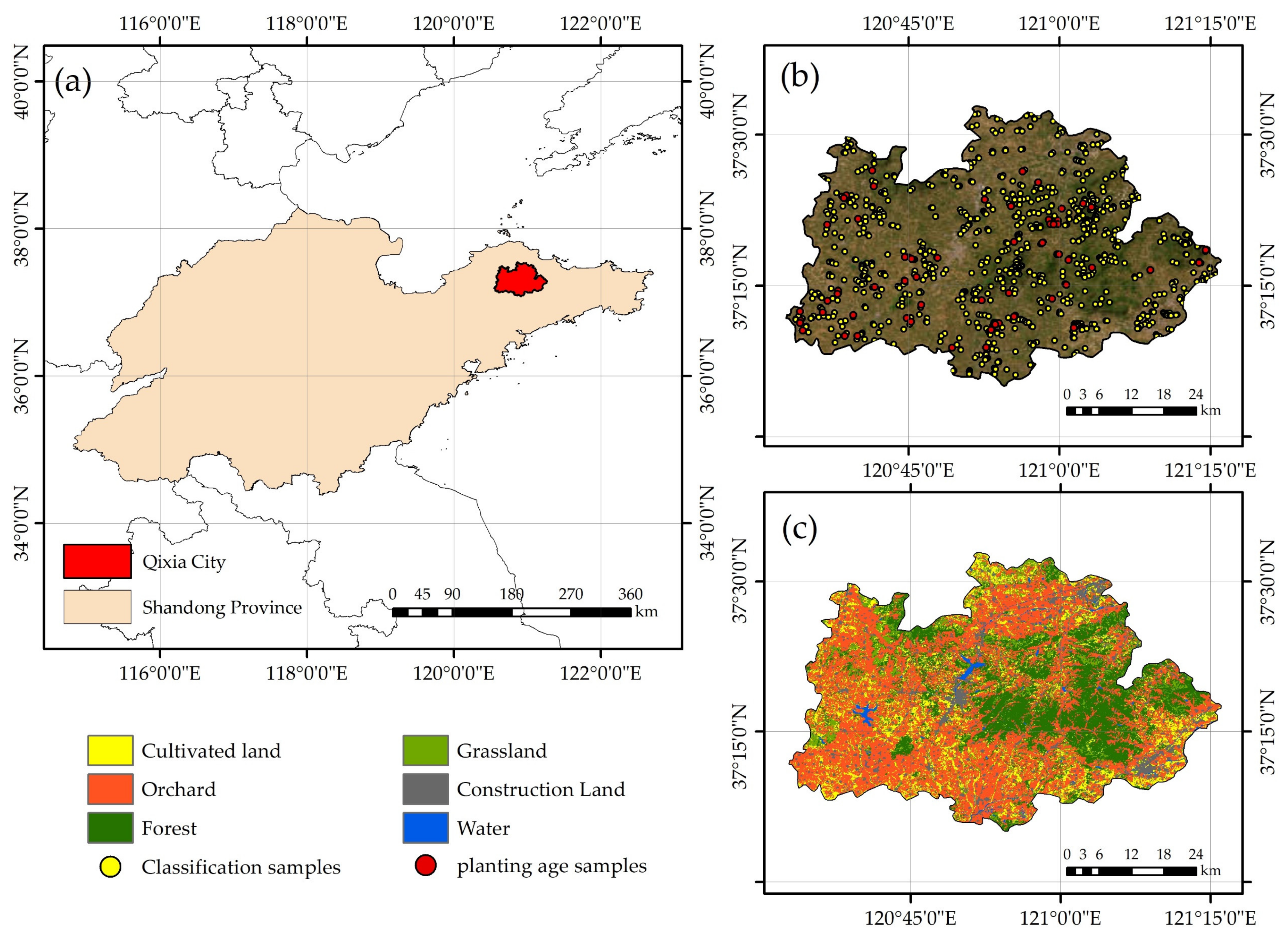

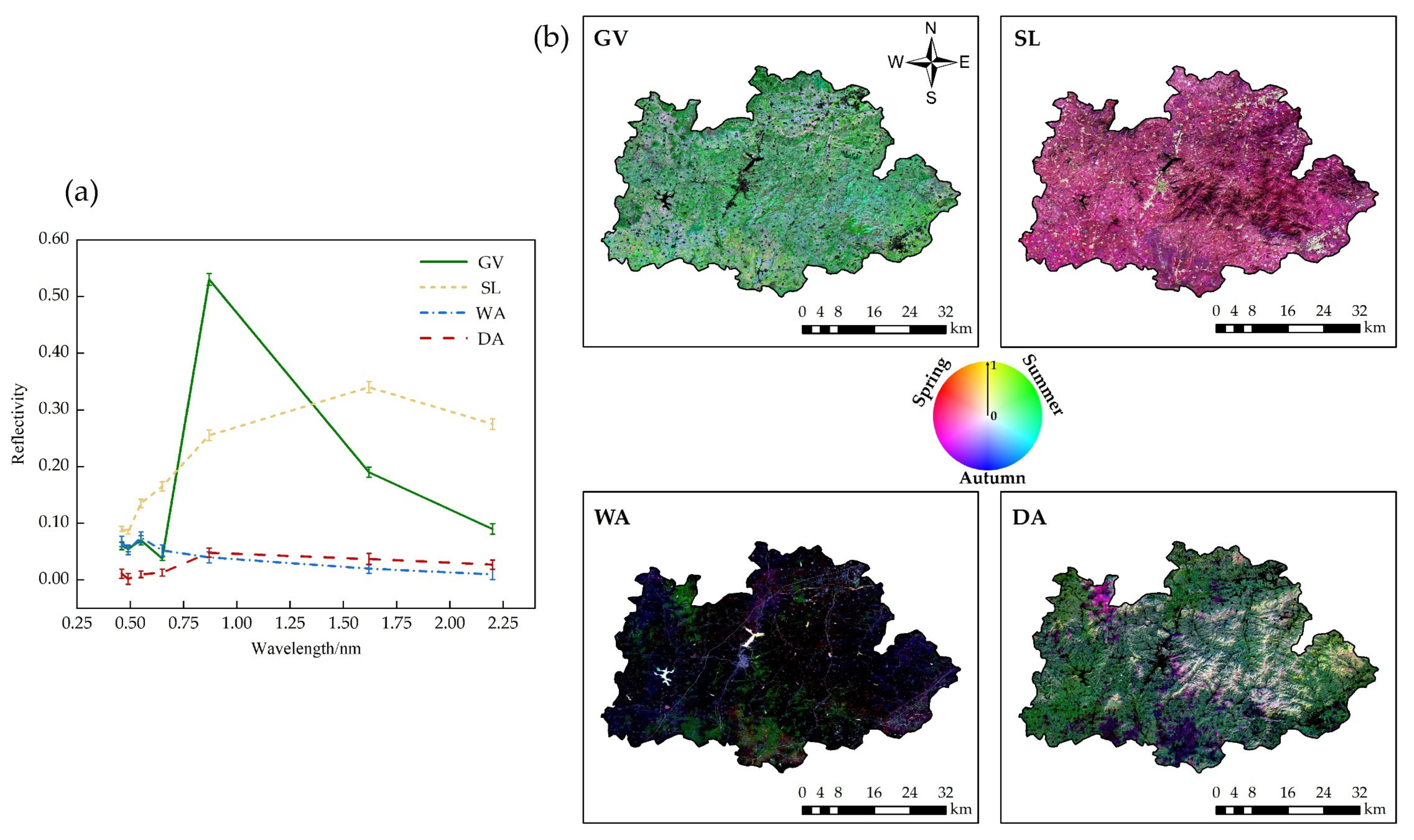
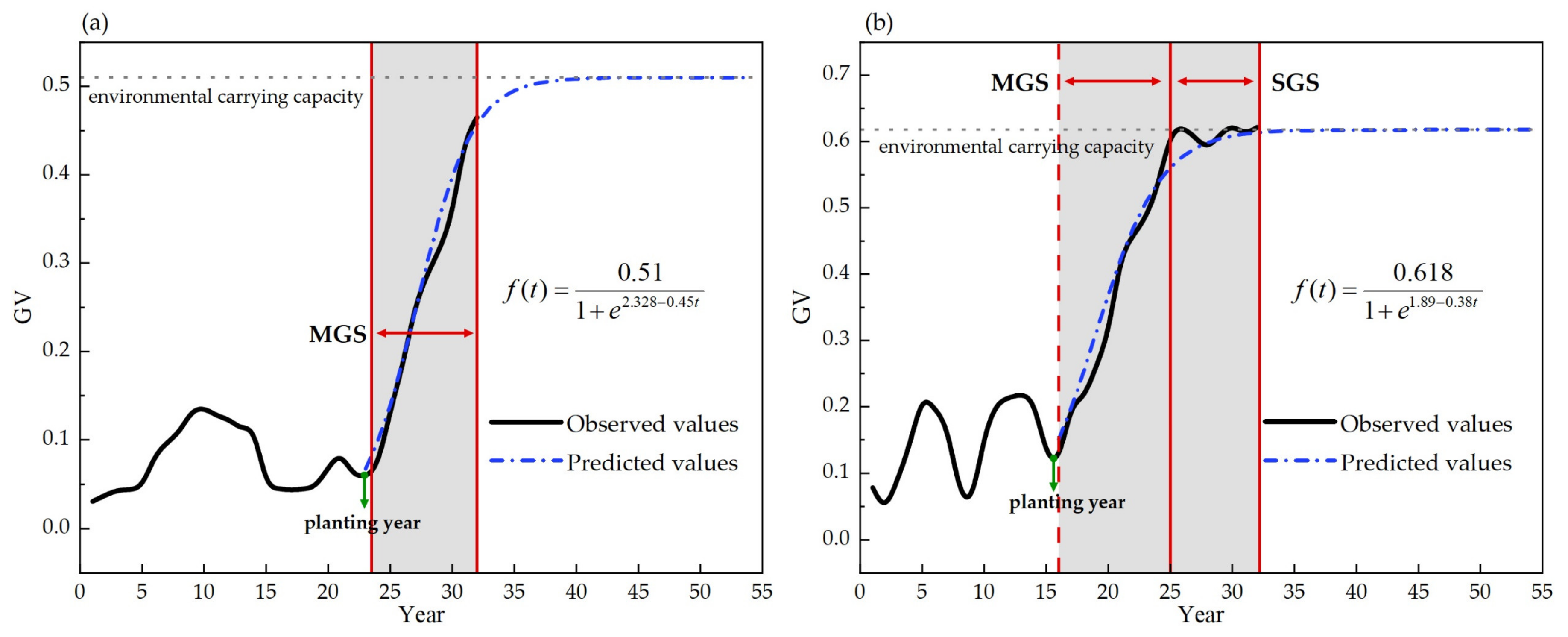
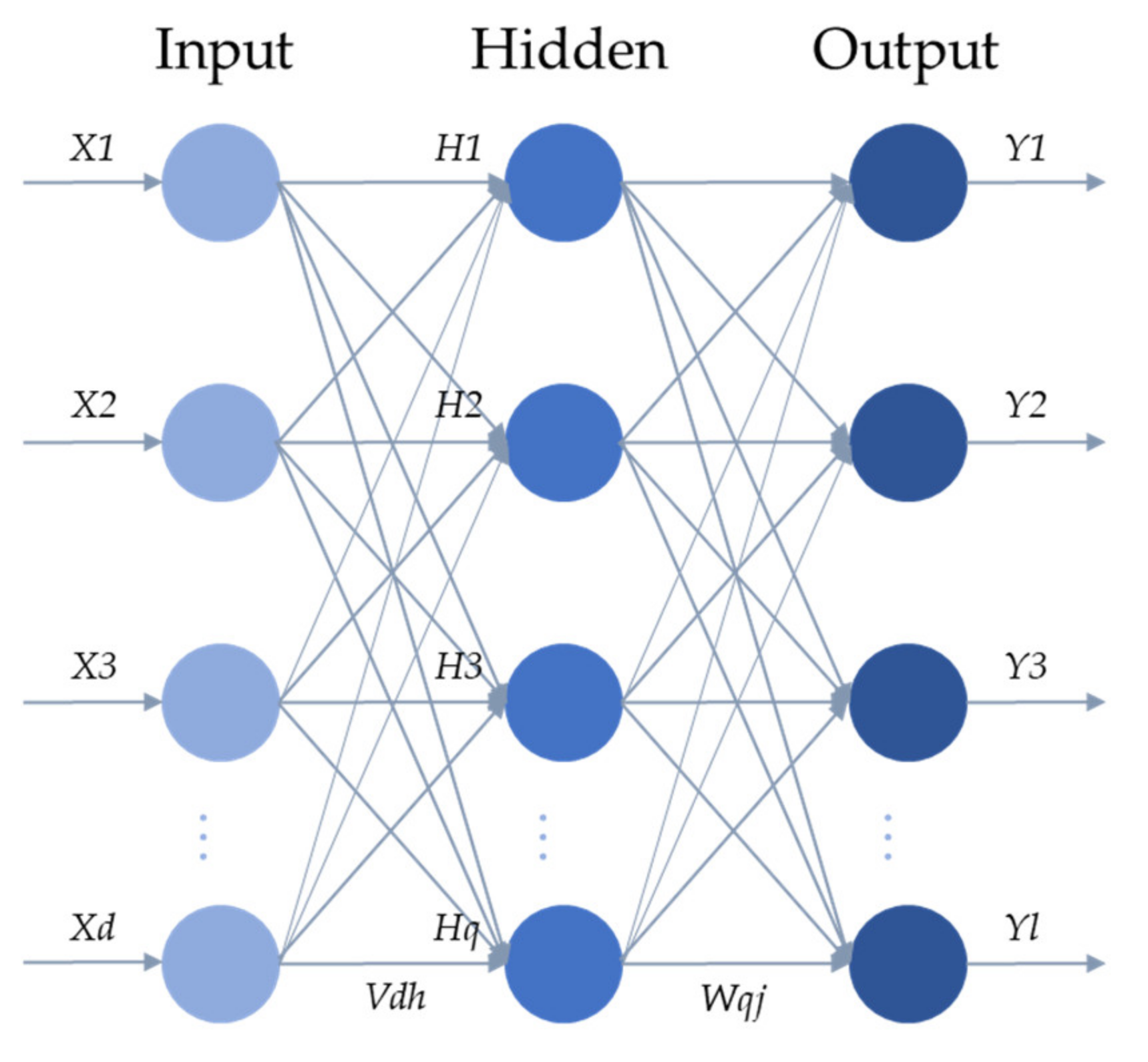

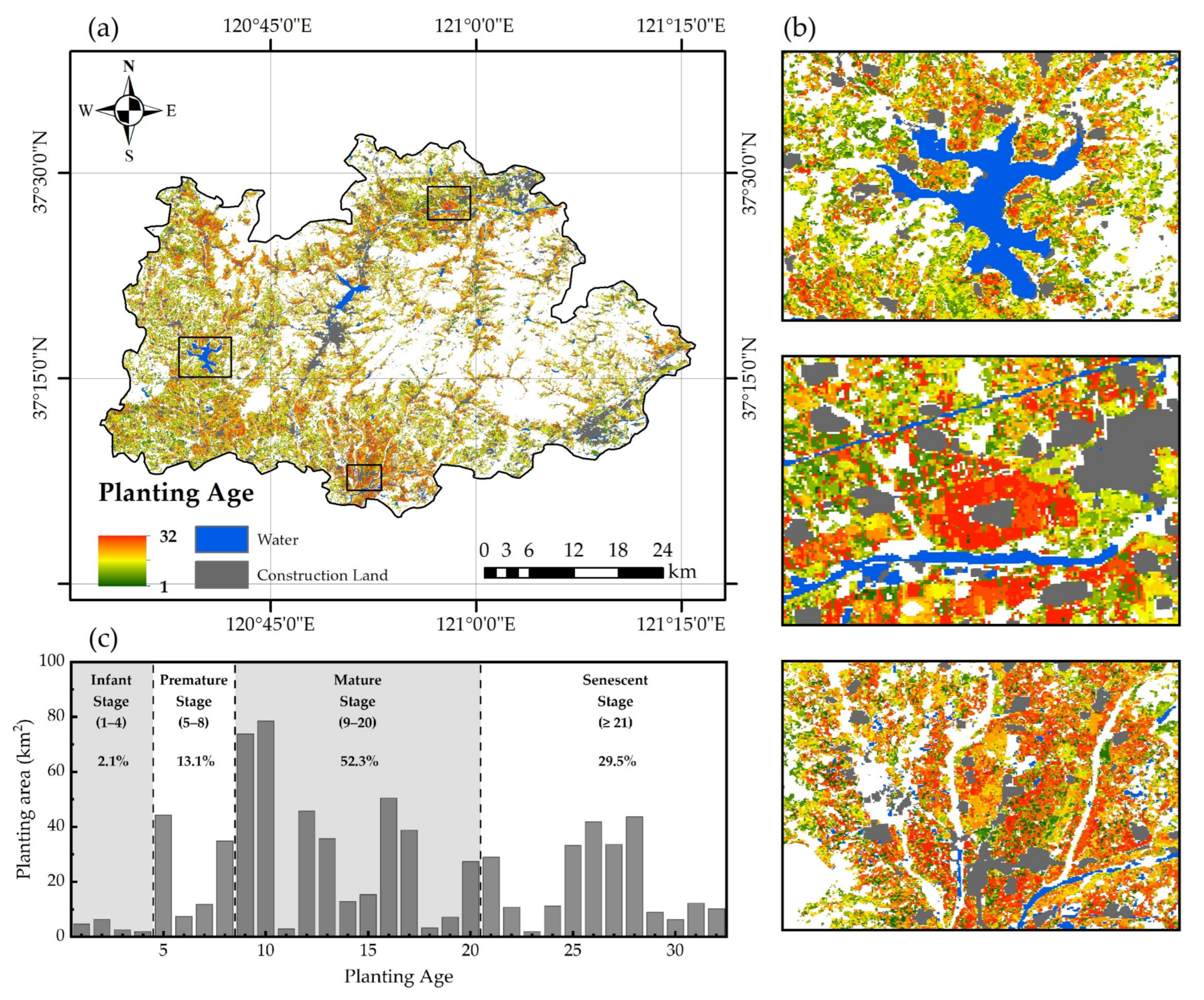

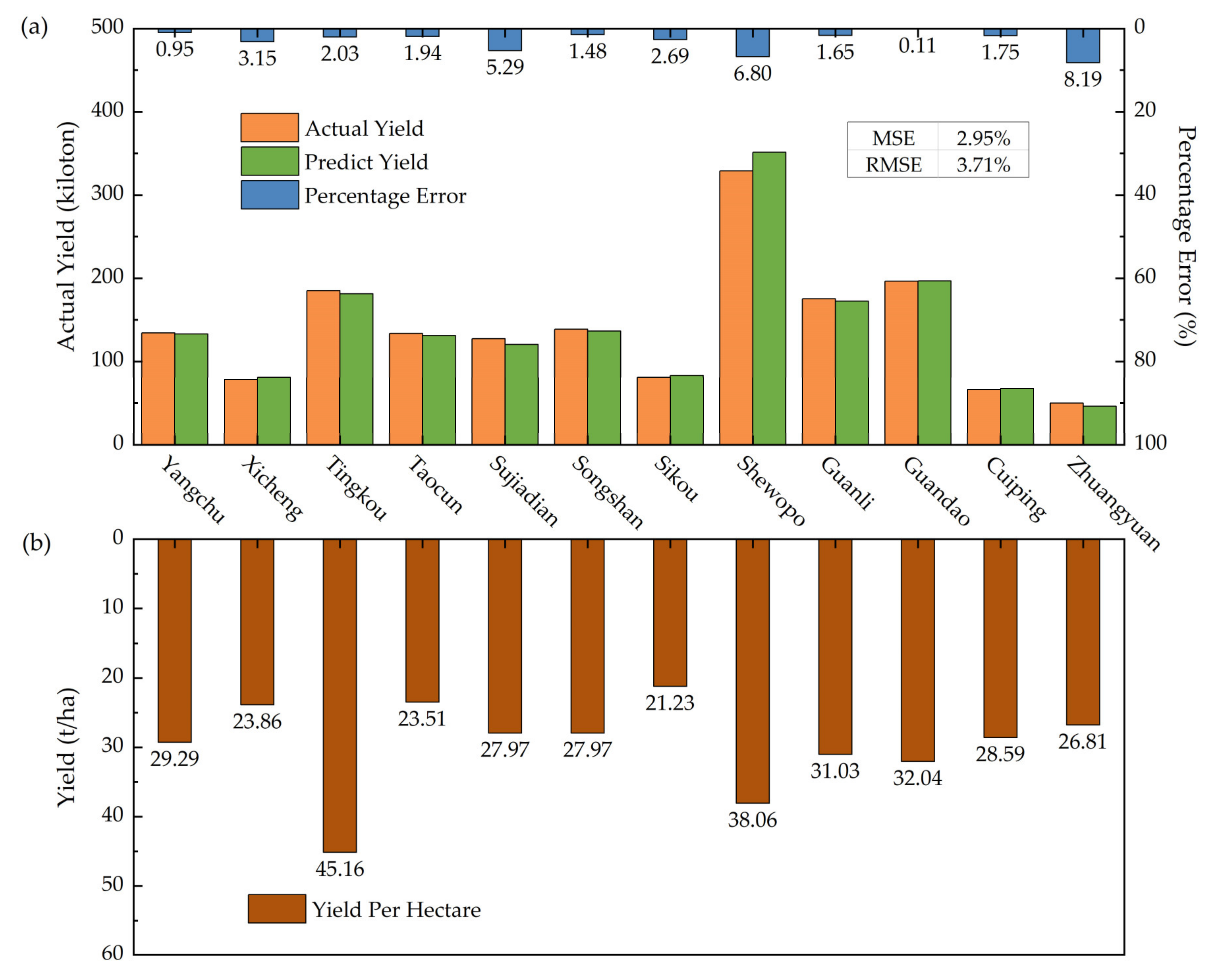
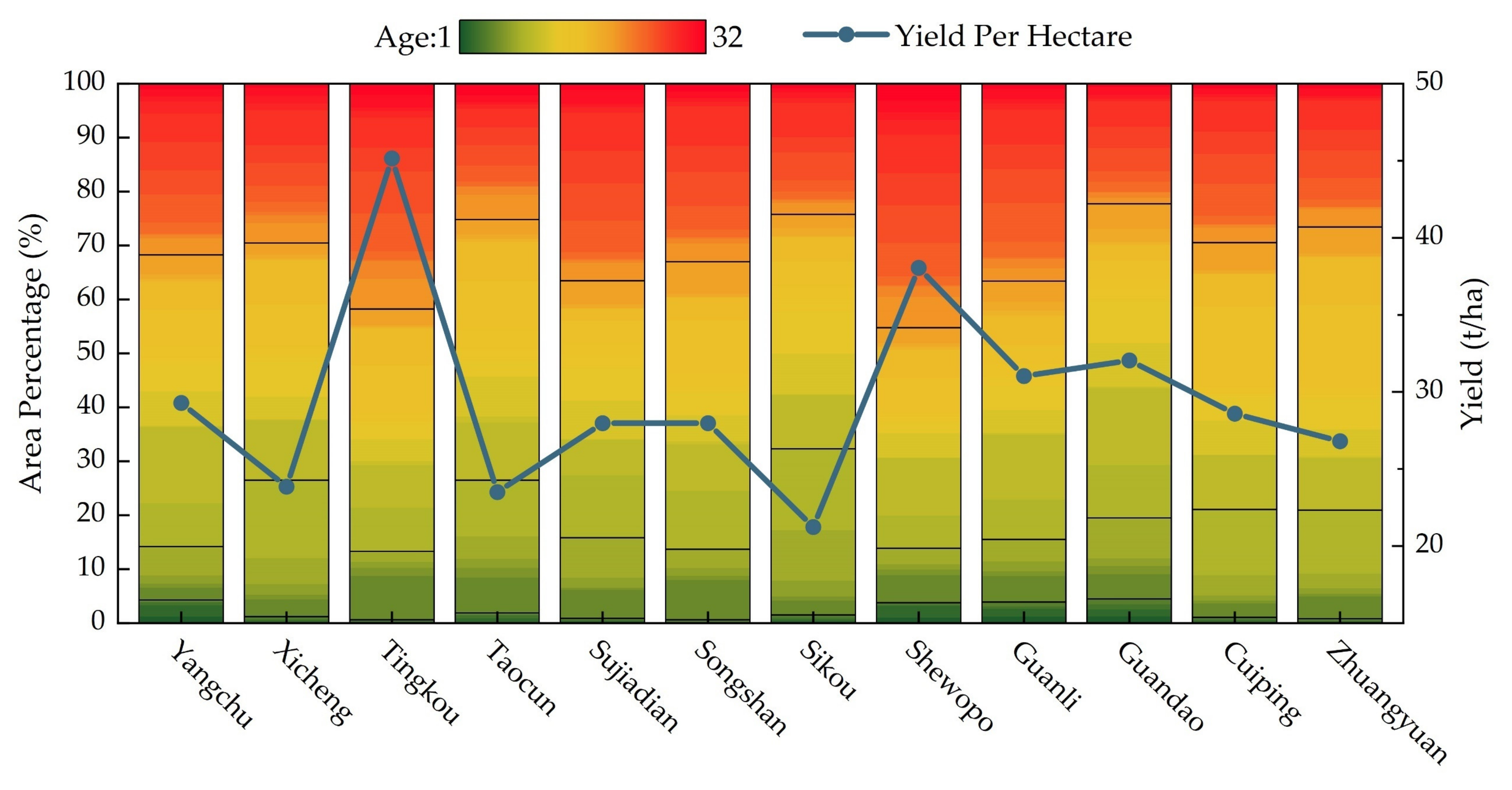
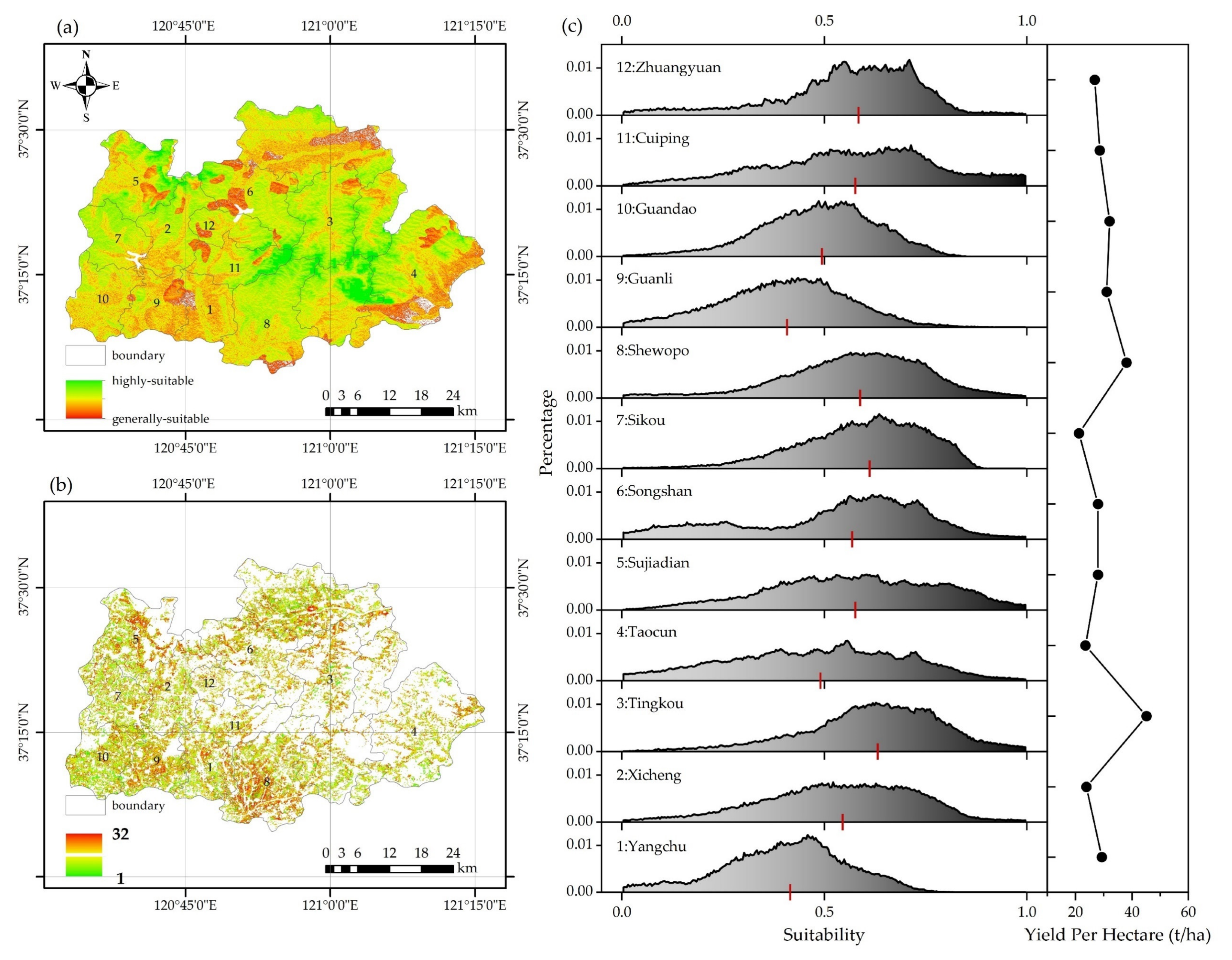
| Classification Result | Water | Construction Land | Grassland | Forest Land | Orchard | Cultivated Land |
|---|---|---|---|---|---|---|
| Water | 96.3% | 3.7% | 0.0% | 0.0% | 0.0% | 0.0% |
| Construction land | 6.1% | 84.8% | 6.1% | 3.0% | 0.0% | 0.0% |
| Grassland | 0.0% | 3.4% | 89.7% | 3.4% | 0.0% | 3.4% |
| Forest land | 0.0% | 0.0% | 3.3% | 80.0% | 13.3% | 3.3% |
| Orchard | 0.0% | 0.0% | 0.0% | 9.5% | 90.5% | 0.0% |
| Cultivated land | 1.6% | 0.0% | 1.6% | 1.6% | 1.6% | 93.5% |
| Producer’s Accuracy | 96.3% | 84.8% | 89.7% | 80.0% | 91.1% | 93.5% |
| Consumer’s Accuracy | 89.7% | 93.3% | 86.7% | 77.4% | 89.1% | 96.7% |
Disclaimer/Publisher’s Note: The statements, opinions and data contained in all publications are solely those of the individual author(s) and contributor(s) and not of MDPI and/or the editor(s). MDPI and/or the editor(s) disclaim responsibility for any injury to people or property resulting from any ideas, methods, instructions or products referred to in the content. |
© 2023 by the authors. Licensee MDPI, Basel, Switzerland. This article is an open access article distributed under the terms and conditions of the Creative Commons Attribution (CC BY) license (https://creativecommons.org/licenses/by/4.0/).
Share and Cite
Gao, X.; Han, W.; Hu, Q.; Qin, Y.; Wang, S.; Lun, F.; Sun, J.; Wu, J.; Xiao, X.; Lan, Y.; et al. Planting Age Identification and Yield Prediction of Apple Orchard Using Time-Series Spectral Endmember and Logistic Growth Model. Remote Sens. 2023, 15, 642. https://doi.org/10.3390/rs15030642
Gao X, Han W, Hu Q, Qin Y, Wang S, Lun F, Sun J, Wu J, Xiao X, Lan Y, et al. Planting Age Identification and Yield Prediction of Apple Orchard Using Time-Series Spectral Endmember and Logistic Growth Model. Remote Sensing. 2023; 15(3):642. https://doi.org/10.3390/rs15030642
Chicago/Turabian StyleGao, Xiang, Wenchao Han, Qiyuan Hu, Yuting Qin, Sijia Wang, Fei Lun, Jing Sun, Jiechen Wu, Xiao Xiao, Yang Lan, and et al. 2023. "Planting Age Identification and Yield Prediction of Apple Orchard Using Time-Series Spectral Endmember and Logistic Growth Model" Remote Sensing 15, no. 3: 642. https://doi.org/10.3390/rs15030642
APA StyleGao, X., Han, W., Hu, Q., Qin, Y., Wang, S., Lun, F., Sun, J., Wu, J., Xiao, X., Lan, Y., & Li, H. (2023). Planting Age Identification and Yield Prediction of Apple Orchard Using Time-Series Spectral Endmember and Logistic Growth Model. Remote Sensing, 15(3), 642. https://doi.org/10.3390/rs15030642






